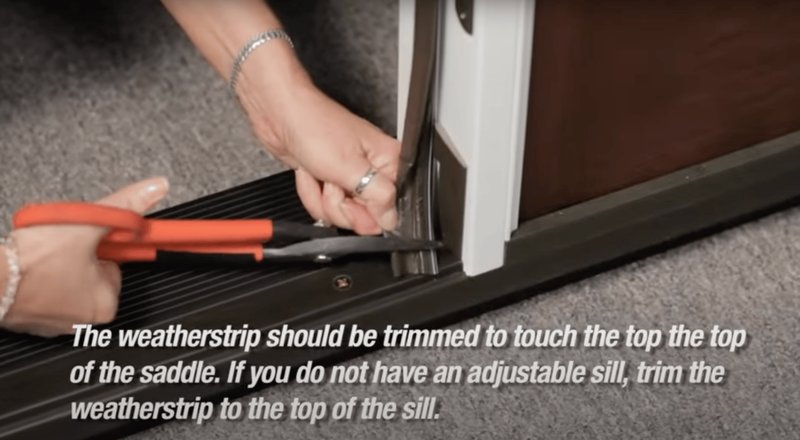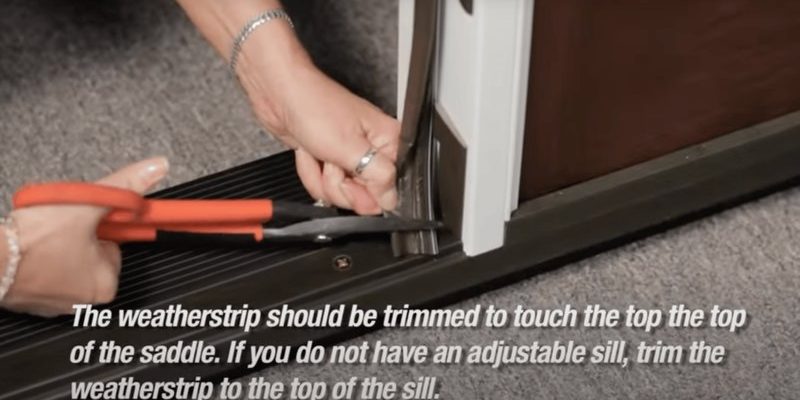
Let’s talk about a common situation: you’ve got a wooden exterior door, maybe something like a classic Masonite or Jeld-Wen. These doors often have V-seal weatherstrips factory-installed in a channel around the edge. When that V-seal wears out, all of a sudden your door doesn’t seal tight. Air gets in, the hallway smells like outside, and your “weatherproof” entry feels more like a revolving door at a hotel. Don’t worry—repairing a damaged V-seal on this kind of door is totally doable, even if you’ve never done it before.
What Is a V-Seal Weatherstrip, and Why Does It Matter?
A V-seal weatherstrip is a simple but effective tool for stopping drafts around doors and windows. It’s called a V-seal because it’s shaped like—you guessed it—a little “V” when you look at it from the side. When you close your door, the point of the V gets compressed, sealing up the gap between the door and the frame. This is what keeps out cold air in winter and sticky heat in summer.
Here’s the thing: Most wooden exterior doors, especially brands like Jeld-Wen or Masonite, use V-seals either stuck onto the frame or pressed into a dedicated groove. These strips can be made from plastic, vinyl, or even springy metal for heavy-duty doors. Over time, sunlight, moisture, and just regular opening and closing can make them brittle, loose, or torn. That’s when you start noticing drafts, rattling sounds, or even bugs sneaking in.
Honestly, a damaged V-seal weatherstrip is a tiny problem that can make a big difference in comfort—and in your utility bill. Replacing or repairing it doesn’t just save money; it keeps your space feeling like home. If you’ve never thought about the weatherstrip before, you’re not alone. But once you see how much it matters, you won’t want to ignore it again.
How to Tell If Your V-Seal Weatherstrip Needs Repair
You might be wondering, “How do I know my V-seal needs fixing?” It’s not always obvious just by looking at the door. Sometimes you’ll feel a cold breeze, or the door will start to close with a thunk instead of a soft whoosh. Here are some signs to watch for:
- Visible cracks, tears, or flaking in the weatherstrip
- Drafts—you feel air movement around the edges, especially on windy days
- Increased noise from outside, like traffic or neighbors
- Light peeking through the edge of the closed door
- Difficulty closing or latching the door (a worn V-seal can bunch up and get in the way)
If you see or feel any of these problems, your V-seal is probably letting you down. Sometimes the strip looks fine but has lost its springiness—it doesn’t press tightly against the door anymore, letting air sneak past. A quick way to check? Close the door on a piece of paper and try to pull it out. If it slides out easily, your weatherstrip isn’t sealing like it should.
Choosing the Right Replacement V-Seal Weatherstrip
Not all V-seal weatherstrips are the same. You’ll find different sizes, materials, and brands at your local hardware store or online. For a Masonite or Jeld-Wen wooden door, you’ll typically need a self-adhesive V-seal (for stick-on applications) or a press-in V-seal if your door has a special groove or channel.
When picking a replacement, pay attention to:
- Width and length—measure your old strip and the door edge before buying
- Material—plastic and vinyl are common, but metal V-seals last longest for heavy use
- Adhesive type—some V-seals come with a peel-and-stick backing for easy install
- Compatibility—some brands make specific “OEM” (original equipment manufacturer) V-seals for their doors
Let me explain: If your door has a groove, check its shape and depth. Some V-seals are designed for a T-shaped slot, others just need a flat surface. Bring a small piece of your old weatherstrip with you to the hardware store—trust me, that’s way less stressful than guessing in the aisle or waiting for an online order that doesn’t fit.
Removing the Old, Damaged V-Seal—Step by Step
Now for the hands-on part. Removing a damaged V-seal is usually straightforward, but there are a few things to keep in mind so you don’t accidentally damage your door. Here’s how to do it:
- Open the door fully so you can reach the weatherstrip easily. Prop it if it wants to swing shut.
- Locate the V-seal: On many Jeld-Wen and Masonite doors, it runs in a groove along the edge. If it’s stuck on, look for where the adhesive starts peeling.
- Gently pull out or peel back the weatherstrip. Use a putty knife or flat screwdriver if needed, but be careful not to scratch the surface.
- Remove any adhesive residue with rubbing alcohol or a mild adhesive remover on a soft cloth.
- Clean the groove or edge—dust and dirt will keep the new strip from sticking or sitting right.
The goal is to keep the channel or door edge as clean and smooth as possible. If you spot any bits of the old V-seal still stuck, don’t just yank—use your tool to gently lift them free so you don’t gouge the wood or finish. If you’re feeling impatient (I get it), just remember that a clean surface helps your new V-seal last much longer.
Installing the Replacement V-Seal on a Wooden Door
Here’s where things come together. Installing the new V-seal is actually pretty satisfying—you’re sealing up your door, one step at a time. Follow these steps for a neat, reliable fix:
- Cut the V-seal to length: Hold the strip up to the door edge and mark where it needs trimming. Always cut a little longer than you think, then trim any excess once it’s in place.
- Press-in V-seal: If your door has a groove, gently press the V-seal into the channel, working from one end to the other. Make sure the V faces the right direction so it compresses when the door closes.
- Adhesive V-seal: For stick-on strips, peel off a few inches of backing at a time. Press the strip firmly onto the edge, smoothing it as you go so there are no bubbles or gaps.
- Check the fit: Close the door slowly and see if the seal compresses evenly. Adjust as needed before trimming the final bit.
Sometimes, especially on older doors, the groove may have widened or splinters might keep the strip from sitting flat. Use a utility knife to clean up the groove if that’s the case. If your new V-seal resists going in, don’t force it—wiggle it gently, or use a wood dowel to help press it evenly into place.
Testing the Door After Repair: What to Look For
You’ve just installed your new weatherstrip. Now what? It’s time for a quick check to make sure everything works as it should. This isn’t rocket science, but it’s easy to overlook little details in the rush to be done.
- Close the door and listen for any scraping, rubbing, or odd noises.
- Check for drafts with your hand, a candle, or even a piece of tissue around the edges.
- Look for gaps—if you see daylight, go back and adjust the weatherstrip in that area.
- Open and close the door several times to make sure the strip doesn’t shift or peel.
Here’s the thing: If your door is suddenly hard to close, the new V-seal might be too thick. Don’t worry—most seals compress over time, but if it’s really tough, use a thinner strip or trim the spot that’s too tight. The goal is a snug, not jammed, fit.
For the best results, check your seal again after a week. Sometimes the adhesive sets or the strip adjusts with use, and you might need to make tiny tweaks for a perfect fit.
Common Problems and Troubleshooting Tips
Even if you follow every step perfectly, things can go sideways. Maybe the new V-seal won’t stay put, or your door still feels drafty afterward. Don’t sweat it—most fixes are pretty quick.
- If the V-seal won’t stick: Double-check that the surface is clean and dry. Some doors have oily finishes that need extra scrubbing before the adhesive will hold.
- If the strip pops out of the groove: The channel may be worn. Try a slightly wider strip, or use a dab of weatherproof adhesive to help anchor it.
- Drafts still sneak through: You may have missed a section, used the wrong size, or the door might be warped. Look closely and replace any other worn weatherstrips.
- Difficulty latching: Sometimes, especially on older doors, a new, thick V-seal can shift how the latch lines up. Give it a few days, or file a tiny bit from the strike plate if needed.
You might be tempted to patch a small tear with tape, but honestly, that’s only a temporary fix. V-seals are cheap—do the full repair and you’ll thank yourself next winter. If you’re running into a truly stubborn problem, ask your hardware store for advice; they’ve usually seen it all.
Alternatives to V-Seal Weatherstrips: Are There Better Options?
Sometimes you’ll wonder if there’s an easier or longer-lasting fix than V-seals. Truth be told, there are lots of weatherstrip options—foam tape, metal spring seals, magnetic strips, and even custom-made gaskets. Here’s how V-seals stack up:
- V-seals are great for wooden doors with existing grooves—they’re affordable, easy to install, and don’t usually interfere with how the door looks or works.
- Foam tape is cheap and sticks almost anywhere, but it tends to wear out faster, especially on exterior doors.
- Metal spring strips last longer and provide a tighter seal, but can be a pain to install and sometimes look a little industrial.
- Magnetic or silicone gaskets are often used on steel doors or ultra-modern builds, but aren’t usually needed unless you’ve got a big gap or special requirements.
If your door is really old, warped, or you just can’t get a good seal with anything off the shelf, you might need a pro to adjust or rebuild the frame. But for most Masonite or Jeld-Wen wooden doors, replacing the V-seal is the simplest, most effective move.
Wrapping Up: Enjoy a Cozier, Quieter Space
Repairing a damaged V-seal weatherstrip on your wooden door isn’t rocket science, but it does make a big impact. With a fresh V-seal, your door will close quietly, your home stays draft-free, and those annoying outside noises fade away. The best part? You don’t need fancy tools or special skills—just a little patience and the right materials.
Remember, small repairs like this are the secret to a comfortable, energy-efficient home. Don’t ignore those tiny strips along the door edge; they do a lot more than you think. Next time you feel a draft or hear your door rattle, you’ll know exactly what to do.
